Roger Clarke's Web-Site
© Xamax Consultancy Pty Ltd, 1995-2024

Infrastructure
& Privacy
Matilda
Roger Clarke's Web-Site© Xamax Consultancy Pty Ltd, 1995-2024 |

|
|||||
| HOME | eBusiness |
Information Infrastructure |
Dataveillance & Privacy |
Identity Matters | Other Topics | |
| What's New |
Waltzing Matilda | Advanced Site-Search | ||||
Version of 14 July 1994, with an Erratum of 5 July 2005
© Xamax Consultancy Pty Ltd, 1992, 1993, 1994, 2005
Available under an AEShareNet ![]() licence or a Creative
Commons
licence or a Creative
Commons  licence.
licence.
This document is at http://www.rogerclarke.com/SOS/StratISTh.html
In the section below headed 'Porter's Strategic Theory', in the headings for Exhibits 4 and 5, the 'value chain' concept is attributed to Porter (1980). That should have been Porter (1985), where it is treated in depth in Chapter 2, pp. 33-61.
I can find little that supports my original attribution to the 1980 book. The only relevant segments appear to be pp. 17-21 (on intensity of rivalry among existing competitors), chapter 7 on pp. 126-155 (on structural analysis within industries), and p. 207-208 (on increased value added). This matters to any historian of strategic IS theory, because the 1980 book was all about competition, and little at all about the later notion of 'collaborate to compete'.
During the last 15 years, an area has developed within the Information Systems discipline which is generally referred to as 'strategic information systems'. It concerns itself with systems whose importance to the organisation extend beyond merely assisting it to perform its existing functions efficiently, or even just effectively. A strategic information system is instrumental in the organisation's achievement of its competitive or other strategic objectives.
This paper presents a critical summary of the literature, and is accompanied by an extensive reference list. It begins by tracing the development of contemporary theory about strategic uses of corporations' internal information systems, primarily from Porter's theories relating to competitive strategy. This leads to discussion of systems which transcend the boundaries of particular organisations and are associated with cooperation between them. The process whereby strategic information systems are created or identified is then examined.
A number of weaknesses in the existing body of theory are identified, and suggestions made as to directions in which knowledge is or may be progressing.
The topic of 'strategic information systems' is concerned with systems which contribute significantly to the achievement of an organisation's overall objectives. The body of knowledge is of recent origin and highly dynamic, and the area has an aura of excitement about it.
It is risky to attempt a historical exposition of such a recently emerged topic. On the other hand, the line of development which the conventional wisdom has followed is itself interesting and instructive. This paper is prepared as an introduction to the literature, but embodies interpretation in both its structure and its expression, and should therefore be read with at least as critical a disposition as any other paper in the area. It may also be compared with other critical interpretations such as Swatman & Swatman (1992), Galliers (1993) and Ciborra (1994).
The notion and its origins are first discussed. The emergence of the key ideas is then traced. The process whereby strategic information systems come into being is assessed. Finally, areas of weakness are identified, and directions of current and future development suggested.
The role of Information Systems (IS) has developed during the years. The original conception was of automation of existing manual and pre-computer mechanical processes. This was quickly succeeded by the rationalisation and integration of systems. In both of these forms, IS was regarded primarily as an operational support tool, and secondarily as a service to management.
During the 1980s, an additional potential was discovered. It was found that, in some cases, information technology (IT) had been critical to the implementation of an organisation's strategy. The dominant sense in which the term is used is that a strategic information system (SIS) is an information system which supports an organisation in fulfilling its business goals.
An alternative interpretation of the term is that it is not necessary a particular IS, but rather the combination of those parts of an organisation's cluster of information systems which provide information into its strategic planning processes (Higgins & Vincze 1993. p.93). The functions involved include the gathering, maintenance and analysis of data concerning internal resources, and intelligence about competitors, suppliers, customers, government and other relevant organisations.
A variety of interpretations of strategy exist, most of which have a great deal to do with competition between corporations. Chamberlin's theory of monopolistic competition sees corporations as being heterogeneous, and competing on the basis of asset differences, such as technical knowledge, reputation, ability for teamwork, organisational culture and skills, and other 'invisible assets' (Chamberlin 1933, Itami 1987). Competition therefore means cultivating unique strengths and capabilities, and defending them against imitation by other firms. Another alternative sees competition as a process linked to innovation in product, market, or technology (Schumpeter 1950).
The context within which SIS theory emerged was the competitive strategy framework put forward by Porter (1980, 1985), which was based on industrial organisation economics. For developments along that path, see Kaufmann 1966, Kantrow 1980, Pyburn 1981, Parsons 1983, EDP Analyzer 1984a, 1984b, McFarlan 1984, Benjamin et al 1984, Wiseman & Macmillan 1984, Ives & Learmonth 1984, Cash & Konsynski 1985, Porter & Millar 1985, Keen 1986, King 1986). This first section outlines the basis of that theory. Strategic information systems theory will then be shown to be concerned with the use of information technology to support or sharpen an enterprise's competitive strategy.
Competitive strategy is an enterprise's plan for achieving sustainable competitive advantage over, or reducing the edge of, its adversaries. In Porter's view, the performance of individual corporations is determined by the extent to which they cope with, and manipulate, the five key 'forces' which make up the industry structure:
Porter's classic diagram representing these forces is reproduced in Exhibit 1. Enterprises, through their strategies, can influence the five forces and the industry structure, at least to some extent.
There are two basic strategic stances that enterprises can adopt:
In the long run, firms succeed relative to their competitors if they possess sustainable competitive advantage in either of these two, subject to reaching some threshhold of adequacy in the other. In Exhibit 2, Somogyi & Galliers (1987) provide examples of applications of information technology which are consistent with these two strategic stances, mapped against the particular enterprise activities to which they contribute.
Another important consideration in positioning is 'competitive scope', or the breadth of the enterprise's target markets within its industry, i.e. the range of product varieties it offers, the distribution channels it employs, the types of buyers it serves, the geographic areas in which it sells, and the array of related industries in which it competes.
Under Porter's framework, enterprises have four generic strategies available to them whereby they can attain above-average performance. They are:
Porter's representation of them is reproduced in Exhibit 3.
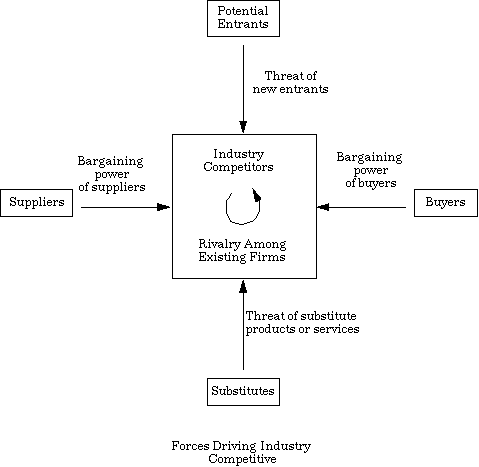
According to Porter, competitive advantage grows out of the way an enterprise organises and performs discrete activities. The operations of any enterprise can be divided into a series of activities such as salespeople making sales calls, service technicians performing repairs, scientists in the laboratory designing products or processes, and treasurers raising capital.
Low Cost Differentiation
Product Design * Production engineering * R&D databases *
and Development systems * Project control Professional work stations *
systems Electronic mail * CAD *
Custom engineering systems *
Integrated systems to
manufacturing
Operations * Process engineering * CAM for flexibility *
systems * Process control Quality assurance systems *
systems * Labor control Systems to suppliers *
systems * Inventory Quality monitoring systems
management systems * for suppliers
Procurement systems
Marketing * Streamlined distribution * Sophisticated marketing
systems * Centralised systems * Market databases *
control systems * IT display and promotion *
Econometric modelling Telemarketing * Competition
systems analysis systems * Modelling
capabilities * High service
level distribution system
Sales * Sales control systems * * Differential pricing
Advertising monitoring systems * Office-field
systems * Systems to communication * Custom-sales
consolidate sales function support * Dealer support
* Strict systems * Systems to customers
incentive-monitoring
systems
Administration * Cost control systems * * Office automation for
Quantitative planning and integration of functions *
budgeting systems * Office Environment scanning and
automation for staff nonquantitative planning
reduction systems * Teleconferencing
By performing these activities, enterprises create value for their customers. The ultimate value an enterprise creates is measured by the amount customers are willing to pay for its product or services. A firm is profitable if this value exceeds the collective cost of performing all of the required activities. To gain competitive advantage over its rivals, a firm must either provide comparable value to the customer, but perform activities more efficiently than its competitors (lower cost), or perform activities in a unique way that creates greater buyer value and commands a premium price (differentiation).
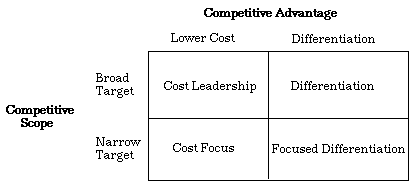
Many differentiation bases exist, classified into four major groups (Borden 1964, quoted in Wiseman 1988):
IT can be used to support or sharpen the firm's product through these various attributes.
Of especial importance is 'product differentiation'. This is the degree to which buyers perceive products from alternative suppliers to be different, or as it is expressed by economic theory, the degree to which buyers perceive imperfections in product substitutability. The buyers of differentiated products may have to pay a price when satisfying their preference for something special, in return for greater added-value. The connection between the producer and buyers may be reinforced, at least to the level of customer loyalty, and perhaps to the point of establishing a partnership between them. Such a relationship imposes 'switching costs' on the buyer, because its internal processes become adapted to the beneficial peculiarities of the particular factor of production, and use of an alternative would force internal changes. Hence product differentiation also serves as an entry barrier. In addition, a continuous process of product differentiation may produce an additional cost advantage over competitors and potential entrants, through intellectual property protections, such as patents, and the cost of imitation.
The activities performed by a particular enterprise can be analysed into primary activities, which directly add value to the enterprise's factors of production, which are together referred to as the 'value chain', and supporting activities. Exhibit 4 reproduces Porter's diagram.
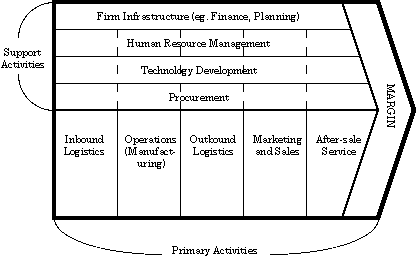
The primary, value-adding activities include those involved in the production, marketing delivery, and servicing of the product. They are linked, generally in a chain. Support activities include those providing purchased inputs, technology, human resources, or overall infrastructure functions to support the primary activities.
By co-ordinating linked activities, an enterprise should be able to reduce transaction costs, gather better information for control purposes, and substitute less costly operations in one activity for more costly ones elsewhere. Co-ordinating linked activities is also an important way to reduce the combined time required to perform them. Hence co-ordination is increasingly important to competitive advantage. Gaining competitive advantage requires that an enterprise's value chain be managed as a system rather than as a collection of separate parts. Reconfiguring the value chain, by re-locating, re-ordering, re-grouping, or even eliminating activities is often at the root of a major improvement in competitive position.
An enterprise's value chain for competing in a particular industry is embedded in a larger stream of activities that Porter terms its 'value system', but which might be more usefully referred to as the 'industry value-chain'. This includes suppliers and distribution channels. Exhibit 5 reproduces Porter's representation. Competitive advantage is a function of how well a company can manage the entire industry value-chain. A corporation can create competitive advantage by co-ordinating its links in that chain.

An enterprise's activities are subject to influence from:
Several developments in several different business disciplines have been associated with the value-chain concept. Activity-based costing (ABC - Johnson & Kaplan 1987) is one. Another is business process redesign / business process reengineering (Hammer 1990, Hammer & Champy 1993).
As is commonly the case with emergent areas of study, conventional empirical research was not feasible during the early years. Most of the early literature was anecdotal, mentioning early examples of systems, but lacking references to authoritative papers or case studies. Indeed, details about many of the leading cases only became widely available many years later, e.g. American Airlines (Copeland & McKenney 1988), McKesson (Clemons & Row 1988), and American Hospital Supply [now Baxter] (Main & Short 1989, Venkatraman & Short 1990).
The early papers and books focussed on the 'competitive advantage' which IT could lead to, and were optimistic, even 'upbeat'. It is certainly not contended that these sources were unquestioning, nor that they contained no seeds of the subsequent developments in the theory of strategic application of IT. They were, however, very positive in the tone in which they discussed IT's contribution to corporate strategy.
During the period following 1985, as experience was gathered and deeper studies were reported on, the literature became somewhat more circumspect. The new materials focussed less on the opportunities than on the processes and the pitfalls. Progressively, a collection of qualifications arose to the initial, relatively 'naive' theory (Miron et al 1988, Karimi & Konsynski 1991, Galliers 1993, Kettinger et al 1994). Associated with this phase were new, and often more ambiguous, case studies, including Philadelphia National Bank (Clemons 1990), CALM (Clarke & Jenkins 1993), Minitel (Cats-Baril & Jelassi 1994) and MSAS Cargo (Ives & Jarvenpaa 1994).
One series of papers focussed not on companies which adopted a successful leadership role in the application of IT, but rather on those which followed. They recognised that where one corporation achieved a significant competitive advantage, it quickly became incumbent on its competitors to neutralise that advantage, and hence to avoid 'competitive disadvantage' (Vitale 1986, Warner 1987, Brousseau 1990). The notion of 'competitive necessity' was created to complement that of 'competitive advantage'.
A special case was the phenomenon of 'second-mover advantage', where the first-mover actually incurs a disadvantage. This may arise variously because the pioneer increases the knowledge available about the application (hence driving the risks down); establishes a level of volume (and hence overcomes resistance and drives average costs down); and/or becomes locked into a system which quickly becomes obsolescent (and hence is subject to being overtaken by a well-informed and unencumbered second-mover).
A distinction came to be drawn between 'sustainable' and 'contestable' competitive advantage (Clemons 1986, Feeny & Ives 1989, Ciborra 1992). The thesis was that many kinds of advantage which can possibly be derived from innovative use of IT result only in ephemeral advantage, which is quickly neutralisable by second- and later-movers. A distinction needs to be made between the sustainability of the original advantage, and of any derived advantage (such as increased market share).
An enhancement to the Porter framework of competitive strategy was the notion of 'alliance' (Barrett & Konsynski 1982, Gummesson 1987, EDP Analyzer 1987, Johnston & Vitale 1988, Rockart & Short 1989, Wiseman 1989, Konsynski & McFarlan 1990, Ford 1990, Bowersox 1990). This referred to chains or clusters of organisations which collaborate in order to gain competitive advantage over other, similar organisations, or to neutralise the advantage of one or more competitor organisations.
A further idea which has emerged is that innovation in IT is of strategic importance only if it is compatible with, and preferably leverages upon the company's existing characteristics and advantages (Beath & Ives 1986, Clemons & Row 1987, Ives & Vitale 1988, Hopper 1990). One particularly important facet of this is the notion of 'strategic alignment' of IT policies and initiatives with the directions indicated by the corporation's senior executives (Henderson & Venkatraman 1989, Earl 1989, Broadbent & Weill 1991).
An outline of factors that influence organisation's strategic goals is summarised in Exhibit 6.
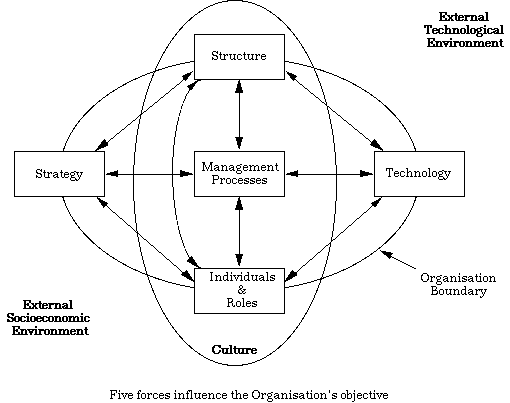
Organisations are facing the reconceptualisation of the role of information technology in business. Scott Morton proposes five levels of complexity at which reconfiguration can be applied. Exhibit 7 reproduces his schematic:
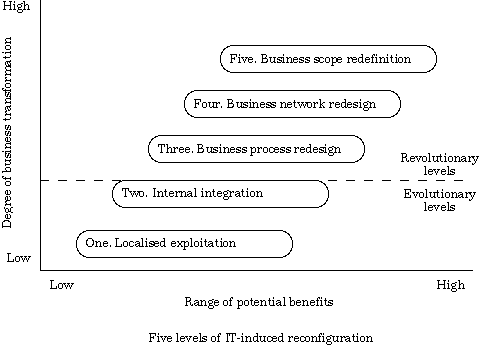
The nature of business governance is conceptualised along a continuum from loosely-coupled (arm's-length, standard relationships like the classic open-market transactions, with relatively low cost to switch from one participant to another) through to tightly-coupled (unique, specialised relationships with high switching costs). The specific mode of functioning is dictated by the nature of the product, of its exchange and of its criticality, which are dictated by the business strategic thrusts and are independent of the IT.
The nature of IT governance ranges from a common role (i.e. the position occupied by any given player is no different from the position occupied by other player in the network, as in the case of adoption of a common EDI standard) to a unique role (e.g. the positions occupied by the different players are different because of their use of a dedicated, proprietary network, or their offering of specialised, valued-added software or other services on the standard communications network). These two dimensions, which resemble the inter-relatedness and exploitability considerations discussed earlier, are summarised in Exhibits 8 and 9.
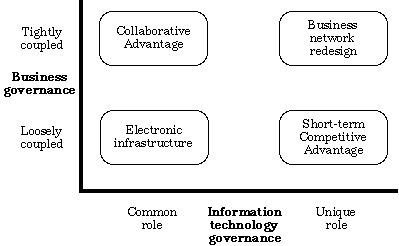
The original orientation of SIS was towards internal systems. Subsequently, attention switched to cooperation among enterprises. Cooperation may take place along the industry value-chain, across industry segments, or between industries. Cooperation may be relatively informal, situational or short-term in nature and based on mutual understanding, or it may take the shape of a more formalised joint venture or alliance.
Cooperation and alliances are fundamentally competitive in nature, in that teams of corporations with at least some degree of common interest seek to gain an advantage over, or neutralise the advantage of, a single enterprise or another team of cooperating or allied enterprises.
Level Theme Potential impacts Major objectives Management
implications
One Localised Potentially high Reduced costs Identify
exploitation savings in and/or improved firm-specific
narrow areas of service areas for
business exploitation
Two Internal Integration Elevate IT as a Articulate the
integration offers both strategic resource logic for
efficiency and integration
effectiveness
Three Business Powerful in Reengineer the Strategy - IT
process creating business with IT alignment
redesign differential lever
capabilities in
the marketplace
Four Business Opportunities Create a virtual Articulate the
network for creatively organisation and logic of
redesign exploiting occupy a central network
capabilities position in the redesign for
network the focal firm
Five Business Altering the Identify new Identification
scope business scope business as well of new scope
redefinition both proactively as potential of business
and reactively threats
Transaction cost economics explains the cooperative relationship among enterprises. It sees them as attempts to increase the utilisation of fixed resources, such as productive capacity, managerial capability, and technological know-how, through closer integration of decisions, and hence improved coordination among economic activities that are not jointly owned: economies of scope and scale enable transaction costs to be reduced. Transaction costs consists of coordination costs and transaction risks. Coordination costs are the costs of coordinating decisions and operations among economic activities, in order to improve resource efficiency. This includes costs to establish and operate information channels and decision processes.
Transaction risk is the possibility of opportunistic behaviour by a party to the relationship leading to uncertainty surrounding the level and division of the benefits from the increased integration of decisions and operations. Transaction risk can be divided into three sub-categories:
Traditional transaction-cost theory assumes that increasing explicit coordination requires specialised sunk investments to decrease coordination costs, but that the sunk nature of these investments substantially increases transaction risk.
The application of IT tends to reduce the coordination costs by reducing the costs of accumulating, storing, and communicating information. It is necessary, however, to to mitigate transaction risk as well, e.g. through modularity and replicability of knowledge, open standards, intuitive user interfaces, and interconnection among networks. However, codified information is much easier to duplicate and transfer without any security measures.
IT-facilitated cooperation among enterprises generally takes one of the following forms:
Scott Morton (1991) proposes that the scope for cooperation is determined by two factors: the degree of inter-relatedness between its production process and that of its suppliers and customers; and exploitability, by which is meant the extent to which the advantage is sustainable rather than contestable. Different industrial structures according are classified according to their inter-relatedness and exploitability, as in Exhibit 10.
The potential for competitive and cooperative behaviour is dependent on the industry's position in the scheme. The higher the exploitability and the higher the inter-relatedness of an industry, the greater the scope for competitive SIS. On the other hand, the lower the interrelatedness and the lower the exploitability, the greater the likelihood of co-operative SIS.
A more substantial degree of cooperation is possible. There are circumstances in which the whole of an industry may suspend competition in respect of some aspect of its operations, and pursue a joint strategy of collaboration. Typical examples are the adoption of standards (such as the dimensions and functional characteristics of interfaces between products, or common messaging systems) and of common infrastructure (such as transport containers and network services providers).
Collaboration may be in the interests of the customers, in that it may result in lower costs, higher quality or greater reliability; and of suppliers, in that it may lead to a reduction in the variability of their customers' demands. It can, of course, be detrimental to the interests of suppliers and/or customers, to the extent that it enables the set of enterprises to exercise market power, or to raise barriers to entry, thereby defend against the entrance of new competitors and hence to permit the emergence of a slothful oligopoly. This requires sufficiently different treatment, that it is deferred until a later section.
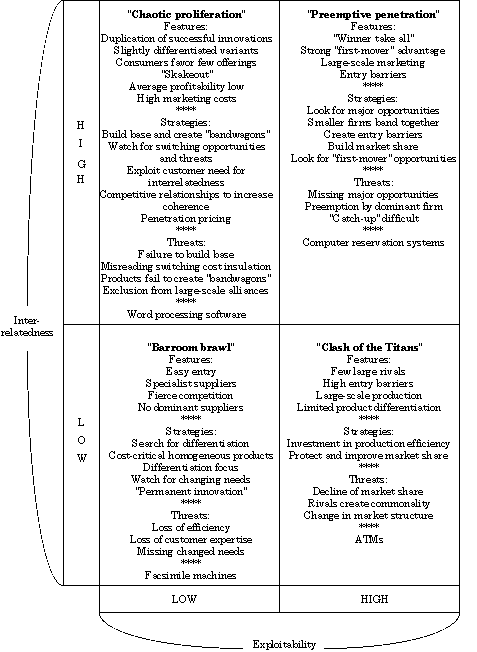
The earlier parts of this paper have focussed on the origins and nature of strategic information systems. This section draws together normative proposals put forward by a variety of authors regarding the way in which organisations can bring strategic information systems into existence, or otherwise exploit IT to achieve competitive advantage.
Porter's 1980 and 1985 books proposed that the enterprise's value chain can be used as a framework for identifying opportunities for competitive advantage. A firm's value activities fall into two broad categories: primary and support. Primary activities are those involved in the physical creation of the product, its marketing and delivery to customers, and its support and servicing after sale. Support activities provide the infrastructure whereby the primary activities can take place. These are linked together to form the enterprise's value chain.
Competitive advantage in either cost or differentiation is a function of this chain. IT is spreading through the value chain, transforming the way value activities are performed and the nature of the linkages among them. It enables an enterprise to better coordinate its activities and thus gives it greater flexibility in deciding its breadth of activities.
Benjamin et al (1984) proposed a strategic opportunities matrix for identifying IT opportunities. They suggested that IT can be used for strategic purposes not only in the marketplace, but also in internal operations. They claimed that most models overlooked the potential strategic impact of applying IT to traditional products and processes, or to changing the firm's current way of doing business. The techniques associated with environmental scanning (Aguilar 1967) can be applied to this process.
Porter and Millar (1985) then proposed the use of an information intensity matrix to assess IT's role. The matrix evaluates the information intensity of the value chain against that of the product. They suggested that IT will play a strategic role in an industry that is characterised by high information intensity in both the value chain and the product. Their representation of the matrix is reproduced in Exhibit 11.
Wiseman (1988) broadened the scope of Porter's model. For Wiseman, competitive advantage is "The dominance of one competitor over another or others in an arena, with factors conducive to its success over a period of time". An organisation's competitive space generally comprises many different arenas, which may be independent or linked. The organisation may possess multiple competitive advantages or disadvantages within or among its arenas.
Wiseman combined his generic strategies with Chandler's growth strategies to produce a 'strategic thrusts' framework intended as a means of identifying strategic IS. Strategic thrusts are major competitive moves made by a firm. Five are postulated:
They are targeted at suppliers, customers and/or competitors. IT can be used to support or shape the enterprise's competitive strategy by supporting or shaping competitive thrusts.
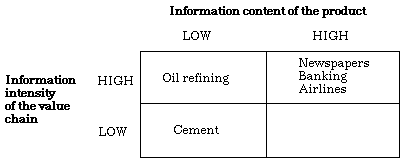
Wiseman then combined his strategic thrusts framework with an analysis of competitive targets to produce a 'strategic option generator', depicted in Exhibit 12. The competitive targets are divided into two groups. System (user) targets are those entities involved with using the application; competitive arena targets are those competitors of the enterprise (suppliers, customers, distribution channels, or rival arenas) whose competitive position is affected by the firm's use of information technology and the thrust it supports or shapes.
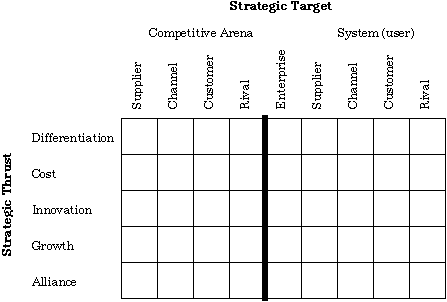
Competitive strategies can be generated through the procedure shown in Exhibit 13. To Porter's and Wiseman's contributions, Earl adds the notions of offensive move and defensive reaction; and use of the strategic measures by the enterprise itself or provision to the target.
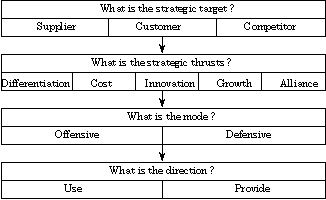
Wiseman's five strategic thrusts require closer attention.
The first 'strategic thrust', differentiation, was discussed earlier.
Strategic cost thrusts are measures intended to:
Economies of scale enable relatively large enterprises to acquire, produce, process, store, ship, or sell products at lower cost per unit than relatively small ones. Important factors in gaining economies of scale include:
At some point, however, diseconomies may set in, due to, for example, increasing bureaucratic inefficiencies, transport charges or lack of local labour.
Economies of Scopeis another form of cost saving. Rather than arising from an expansion in the size of the primary operation, these derive from extension into additional operations which can share the infrastructure costs. Mechanisms include common factors of production, by-products, reuseability, and expertise.
The potential also exists for economies of information whereby relatively knowledgeable firms can acquire, produce, process, store, ship, or sell products at lower average cost per unit than relatively ignorant ones. The sources of information economies run from intelligence on costs, prices, and policies of the enterprise's strategic targets, to data on economic, social, political, and technological trends affecting its products.
Innovation is the adoption of the new products or processes. Product innovation involves the creation of new products, or of new features in existing products, in order to satisfy customer needs or wants which were previously unmet.
Process innovation, on the other hand, improves the efficiency or effectiveness of a process involved in the production or delivery of a product. It generally addresses one or more of the links in an enterprise or industry value-chain. It may involve technological change, organisational change, or often both. An innovation thrust can be aggressive, or employed defensively to imitate or neutralise a competitor's innovation.
There are several ways in which an enterprise can grow:
Growth of any kind tends to be associated with the economies of scale or scope mentioned earlier.
By an alliance, Wiseman means a combination of two or more groups or individuals, whether intra- or supra- to the enterprise, which works together to achieve a common objective. Four types of alliance are identified:
Other important contributions have been made to the process whereby strategic systems are, can be and/or should be uncovered (Wiseman & MacMillan 1984, Rackoff et al 1985, Earl 1986, EDP Analyzer 1986a, 1986b, Vitale et al 1986, Somogyi & Galliers 1987, Madrick 1987, Henderson et al 1987, Lederer & Mendelow 1988, Lederer & Sethi 1988, Laudon & Turner 1989, Main & Short 1989, Clemons & Weber 1990, Clemons 1991, Reich & Huff 1991, Dennis et al 1991, Lederer & Gardiner 1992a, Yetton & Johnston 1993).
One of the findings by Scott Morton's `Management in the 1990s' Program' was that IT is a critical enabler of the re-creation (redefinition) of the organisation. The recognition and exploitation of IT capabilities is fundamental to strategic choices of business scope, governance mechanisms, organisational reconfiguration, and competitive actions in the marketplace.
Approached from a different perspective, IT can be used to create an opportunity for change in organisations, whether or not the technology is actually central to the delivery of the benefits sought. The business process redesign and business process re-engineering (BPR) movements became highly influential during the early 1990s (Hammer 1990, Hammer & Champy 1993). The point was reached where it was difficult to submit papers to conferences, even those of an academic nature, without including the phrase in the title or abstract.
BPR is a further development of the enterprise value-chain notion. What it essentially does is to re-assert that organisational process is more important than organisational structure, and that organisational structure (form) must be determined by what it is that the enterprise does (function). IT is an enabler for BPR, because information systems support data flows, and are hence intrinsically oriented toward function rather than form, and because IT requires re-conception and re-development periodically, and such re-developments cause considerable upheaval and can therefore be used as a catalyst or opportunity for greater change than mere re-automation of existing arrangements.
Other recent theme of relevance to SIS is assessment of IT's contribution to financial performance (e.g. Floyd & Woodridge 1990).
In addition to these well-established lines of analysis, there is a number of areas in which maturation is incomplete. The comments in the remainder of this section are therefore particularly judgmental and tentative.
A first concern is the prevalance of the use of the terms 'comparative advantage' and 'competitive advantage' as though they were equivalent and interchangeable. The notion of 'comparative advantage' was developed many years ago, as one of Ricardo's contributions to 'classical' economics. It refers to the notion of market forces allocating resources to nations where they would be relatively most productive, and is therefore applicable at high levels of aggregation, e.g. national and regional economies.
The idea of 'competitive' advantage differs from comparative advantage in the scale at which it operates. Rather than relating to a broad geo-political area, competitive advantage accrues to individual corporations, provided that they are operating in relatively free-market environments. Although the notion of competitive advantage also originated in micro-economics, it has been much used in marketing and management strategy. The terms are becoming somewhat confused, in that, where enterprises which have competitive advantage are clustered within a country, that country may be said to derive a competitive advantage (Porter 1989, Adcock et al 1993, Soh et al 1993).
Another matter that creates difficulties has been the marked tendency to discuss competitive strategy predominantly in terms of leadership, or 'first-mover' status. The sufficiency of this approach is overdue for careful examination. It is entirely tenable for an organisation to intentionally defer aggressive moves, and instead consciously seek 'second-mover' or 'late-adopter' status. Circumstances in which senior executives may judge this to be the appropriate strategy include where:
A particularly surprising weakness of the existing literature is its inapplicability to organisations which are not subject to powerful market-based competitive forces, such as not-for-profit enterprises, public sector agencies, and associations which are intentionally monopolistic, including industry and professional associations. This is so marked that some definitions of the term 'strategic IS' are restricted to systems that "confer a unique, sustainable, or otherwise significant advantage" (Ciborra 1991).
For organisations of this kind, it is important that strategic information systems theory be re-conceptualised to stress 'strategy' rather than 'competition', and show strategy in a competitive environment as a special (if very important) case. Customers of not-for-profits, of the public sector and of associations have an interest in their efficiency and effectiveness. Incentives need to be expressed not in terms of revenue, market share and growth, but rather in terms of perceived performance against objectives, and benefits delivered to stakeholders. There are also many circumstances in which such organisations are actors in industry value-chains, or have the potential to have significant negative impact on corporations' cost-profiles, or speed of supply. Cooperation and even outright collaboration are important in such areas as defence and aerospace purchasing, international trade, taxation, statistical and corporate registration returns (Clarke 1994a, 1994b).
It is contended that, even in corporations operating in free-market economies, organisational strategy should not be analysed exclusively in competitive terms. Other possible bases include:
This last category (national competitive advantage) highlights the need for recognition of collaboration or cooperation at a level higher than a competitively-motivated alliance (Malone & Yeats 1987, Benjamin et al 1990, Swatman & Clarke 1990, Clarke 1991). Two important classes which can be readily identified are:
The question of collaboration leads to the need to define what comprises public infrastructure, industry infrastructure and private investment, and the extent to which the responsibility for investment is public, private or dual. This issue poses particularly significant difficulties for nations whose traditions and ideology are in conflict with the very notions of collaboration and of publicly-funded infrastructural investment.
Some inferences from Scott Morton (1991) in relation to IT infrastructure are summarised in Exhibit 14.
Characteristic Emerging View
Focus IT platform NOT Isolated systems
Investment vision Business NOT Technological
transformation sophistication
Investment Business criteria NOT Cost-benefit
criteria criteria alone
Scope of impact Business domain NOT IT or IS domains
Executive Strategic (line) NOT IT manager
responsibility manager
Guiding principle Strategic - IT NOT IT for
alignment implementation
A further common feature of most papers to date is the implicit assumption that business needs drive IT and information strategy. There is evidence, however, that, in some organisations, IT strategic planning is driving corporate planning, and that IT can actively assist in the creation of business opportunities, rather than just support them (Oesterle 1991).
Finally, the literature to date generally adopts the attitude that executives do, can or should uncover systems by at least semi-plannable processes. It is apparent that an alternative view may be beginning to emerge. Although it is too early to do more than speculate upon its final shape, it is possible to draw attention to some key works. This section draws heavily on the work of Claudio Ciborra of the Theseus Institute and the University of Bologna, and especially on Ciborra (1991).
In tracing the emergence of the alternative view, Ciborra draws on the economic concepts of Chamberlin (1933), who defined 'monopolistic competition' as heterogeneous corporations "cultivating unique strengths and capabilities, and defending them against imitations by other firms"; and of Schumpeter (1950), who saw competition "as a process linked to innovation in product, market or technology". He then notes the compatibility of these ideas with Mintzberg's (1990) arguments about organisational culture, which question the ability of managers to discover advantage, but rather see advantage emerging from organisational processes.
Innovation "is more the outcome of the capitalist process of creative destruction than the result of a strategic planning process" (Barney 1985). Ability at guessing, learning, and sheer luck appear in such a perspective to be key competitive factors.
Ciborra enlarges on these beginnings, by arguing that innovation with strategic potential can be encouraged in two ways. One is to "rely on local information and routine behaviour, ... allowing and even encouraging tinkering [bricolage] by people close to the operational level". The other is to use 'radical learning' to "intentionally challenge and smash established routines" and "forge new competencies".
In many ways, this argument appears revolutionary, but in other ways it does not. Some of the themes are detectable in the IS and adjacent management literature, particularly in those areas deriving from the Japanese tradition (Nonaka and Yamanouchi 1989), but also in such papers as McGinnis (1984), Henderson & Treacy (1986), Copeland & McKenney (1988) and Earl (1988), and in the notions of 'organisational transformation', IT-induced business re-configuration (Scott Morton 1991), business process re-design (Davenport & Short 1990), and 'renovating the corporation' (Brown 1991).
It is increasingly clear that separating out the effects of IT on such abstract and complex variables as corporate processes and corporate performance, is fraught with difficulties. Conventional empirical research methods (in the sense of the collection of large amounts of data about large populations, followed by statistical analysis in order to test specific hypotheses) is not easy to apply to the topic of strategic information systems. Strategic studies are essentially about the long term, and hence longitudinal studies are highly desirable. Moreover, because of the extent to which multiple perspectives and interpretations are involved, triangulation is important, and data may in many cases have to be drawn from less formal sources not commonly used in formal research. Other problems arise because many of the organisations of interest to researchers are not only large and complex, but also comprise multiple business units. Care must therefore be taken that the appropriate level of aggregation is selected.
With the gradual maturation of the topic of strategic information systems, increased attention is being paid to research methods, and several important papers now take a more carefully considered approach than was possible during the early, anecdote-based phase (Bakos & Treacy 1986, Sager 1988, Sethi 1988, Venkatraman 1989, Clemons & Weber 1990a, Reich & Benbasat 1990, Broadbent & Weill 1991, Chan & Huff 1992, Angéle et al 1993). It is to be expected that further developments and refinements in research methods will emerge during the next few years.
Strategic information systems is a topic which is very important, and highly dynamic. This paper has presented an interpretation of the emergence and development of theory in the area, and of current and emerging themes. Particularly significant tensions exist between the relevance of research outcomes and the rigour of research processes, and the literature must be used with an especially critical eye.
Organisations seek to gain significant advantages by employing SIS to alter the internal structure or the entire industry structure. Several frameworks exist which are intended to assist understanding of the use of SIS based on the industry organisation, value chain, and strategic thrusts. Organisations seek competitive advantages over other rivals along the whole industry value chain. Generic strategies have been proposed.
Despite the usefulness of these frameworks applied to the search for competitive advantages, these frameworks are market-oriented, and are not suitable to explain SIS developed in other non-market-oriented industries, such as government. Another deficiency of these frameworks is the concentration on competitive advantage to the exclusion of other perspectives. As a result of industry-wide adoption of SIS, the questions of sustainability of competitive advantage and of competitive necessity arise. This in turn leads to cooperative arrangements, including alliances, and at a more abstract level, collaboration.
IT has become a significant factor in the operation and planning of information-based enterprises. Strategic information systems theory has done much to enable the description, explanation and prediction of behaviour. There remain significant weaknesses which need to be addressed.
See References
The assistance of Isaac Ho, a graduate student at the Australian National University in 1992-93, is gratefully acknowledged.
An early draft of this paper was presented as 'Strategic Information Systems: Retrospect and Prospect' at the International Conference on Information Systems and Organisations, in Bled, Slovenia in August 1992.
Roger Clarke is Principal of Xamax Consultancy Pty Ltd, Canberra. He is also a Visiting Professor in the Cyberspace Law & Policy Centre at the University of N.S.W., a Visiting Professor in the E-Commerce Programme at the University of Hong Kong, and a Visiting Professor in the Department of Computer Science at the Australian National University.
| Personalia |
Photographs Presentations Videos |
Access Statistics |
 |
The content and infrastructure for these community service pages are provided by Roger Clarke through his consultancy company, Xamax. From the site's beginnings in August 1994 until February 2009, the infrastructure was provided by the Australian National University. During that time, the site accumulated close to 30 million hits. It passed 65 million in early 2021. Sponsored by the Gallery, Bunhybee Grasslands, the extended Clarke Family, Knights of the Spatchcock and their drummer |
Xamax Consultancy Pty Ltd ACN: 002 360 456 78 Sidaway St, Chapman ACT 2611 AUSTRALIA Tel: +61 2 6288 6916 |
Created: 14 July 1994 - Last Amended: 20 November 1995, with an Erratum of 5 July 2005 by Roger Clarke - Site Last Verified: 15 February 2009
This document is at www.rogerclarke.com/SOS/StratISTh.html
Mail to Webmaster - © Xamax Consultancy Pty Ltd, 1995-2022 - Privacy Policy